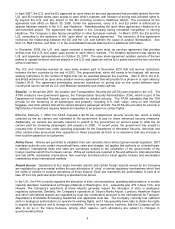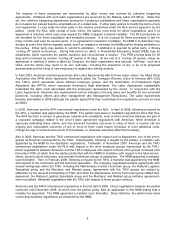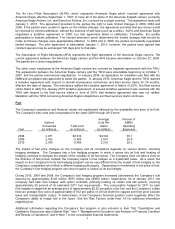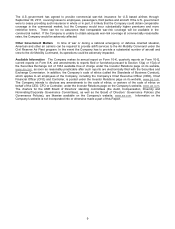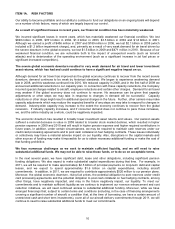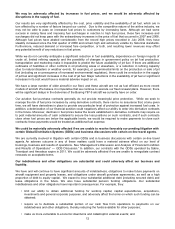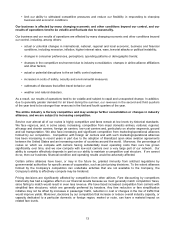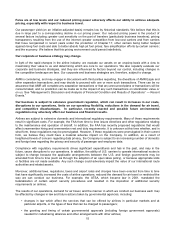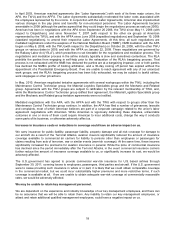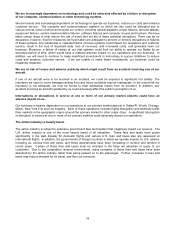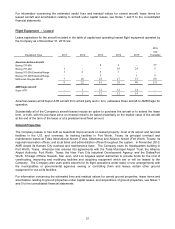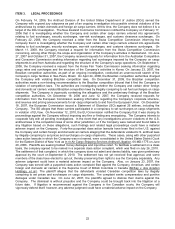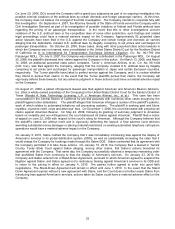American Airlines 2010 Annual Report Download - page 17
Download and view the complete annual report
Please find page 17 of the 2010 American Airlines annual report below. You can navigate through the pages in the report by either clicking on the pages listed below, or by using the keyword search tool below to find specific information within the annual report.
14
There have been numerous mergers and acquisitions within the airline industry and numerous changes in
industry alliances. Southwest Airlines and AirTran Airways announced during 2010 plans to merge, and the recent
mergers of United Air Lines, Inc. with Continental Airlines, Inc. and Delta Airlines with Northwest Airlines
Corporation have resulted in the formation of larger competitors than the Company with more extensive networks
than the Company. We are seeking to address these competitive challenges with our cornerstone market and
alliance strategies; however, there can be no assurances as to the level of success of these strategies.
In the future, there may be additional mergers and acquisitions, and changes in airline alliances, including those
in which the Company may participate and those that may be undertaken by others. Any airline industry
consolidation or changes in airline alliances, including oneworld, could substantially alter the competitive
landscape and result in changes in our corporate or business strategy. We regularly assess and explore the
potential for consolidation in our industry and changes in airline alliances, our strategic position and ways to
enhance our competitiveness, including the possibilities for our participation in merger activity. Consolidation
involving other participants in our industry could result in the formation of one or more airlines with greater
financial resources, more extensive networks, and/or lower cost structures than exist currently, which could have
a material adverse effect on our competitive position and adversely affect our business and results of operations.
For similar reasons, changes in airline alliances could have a similar impact on us.
In 2008, we entered into a joint business agreement and related marketing arrangements with British Airways and
Iberia, providing for commercial cooperation on flights between North America and most countries in Europe,
pooling and sharing of certain revenues and costs, expanded codesharing, enhanced frequent flyer program
reciprocity, and cooperation in other areas. In July 2010, American obtained clearance from the European
Commission (“EC”) and approval by the Department of Transportation (“DOT”) for antitrust immunity (“ATI”) for its
planned cooperation with British Airways, Iberia, Finnair and Royal Jordanian. Regulatory conditions for ATI
approval for the British Airways, Iberia, Finnair and Royal Jordanian cooperative agreement include a collective
obligation of the Company, British Airways and Iberia to lease to other carriers up to seven takeoff and landing
slot pairs at London Heathrow airport and up to three John F. Kennedy airport operational authorities, depending
on market conditions. American began implementation of the JBA with British Airways and Iberia and expanded
cooperation with Finnair and Royal Jordanian in October 2010. No assurances can be given as to any
arrangements that may ultimately be implemented or any benefits that we may derive from such arrangements.
In February 2010, American and JAL announced the decision to strengthen their relationship. The carriers, both
members of the oneworld alliance, jointly applied to DOT for ATI on certain routes, and jointly notified the Ministry
of Land Infrastructure, Transport and Tourism of Japan of the proposed cooperation. As a part of the application,
American and JAL entered into a joint business agreement which will enhance their scope of cooperation on
routes between North America and Asia through adjustments to their respective networks, flight schedules, and
other business activities. This, in turn, will allow both carriers to better complement each other’s operations and to
develop and offer competitive products and quality service to their customers. In November 2010, American
obtained approval by DOT for ATI for its planned cooperation with JAL. Implementation of the JBA with JAL is
subject to successful negotiation of certain detailed financial and commercial arrangements and other approvals.
American expects to begin implementing the JBA with JAL in 2011. No assurances can be given as to any
arrangements that may ultimately be implemented or any benefits that we may derive from such arrangements.
Any plans to enter into or expand ATI joint business agreements or similar arrangements, including
implementation of the joint business agreements referred to above, are subject to various conditions, including
various U.S. and foreign regulatory approvals, successful negotiation of certain detailed financial and commercial
arrangements, and other approvals. Governmental entities from which such approvals must be obtained,
including DOT and foreign governmental authorities or entities such as the EU, have imposed or may impose
requirements or limitations as a condition of granting any such approvals, such as requiring divestiture of routes,
gates, slots or other assets. No assurances can be given as to any arrangements that may ultimately be
implemented or any benefits we may derive from such arrangements.
We compete with reorganized carriers, which results in competitive disadvantages for us.
We must compete with air carriers that have reorganized under the protection of Chapter 11 of the Bankruptcy
Code in recent years, including United, Delta and U.S. Airways. It is possible that other significant competitors
may seek to reorganize in or out of Chapter 11.
Successful reorganizations by other carriers present us with competitors with significantly lower operating costs
and stronger financial positions derived from renegotiated labor, supply, and financing contracts. These
competitive pressures may limit our ability to adequately price our services, may require us to further reduce our
operating costs, and could have a material adverse impact on us.


